The Dell XPS 13 (9300) Review: Return of the King
by Brett Howse on July 16, 2020 10:00 AM ESTWireless
Dell offers two wireless radio options for the XPS 13, and both are Killer-branded. The default wireless card is the Killer Wi-Fi 6 AX1650, which is a 2x2:2 wireless solution based on the excellent Intel AX200. If somehow you missed it, Intel recently acquired Rivet Networks, so the Killer brand should continue to provide the performance and stability of the Intel adapters for the foreseeable future. Dell also lists a second Killer AX500 Wi-Fi 6 option, but this Killer product is based on the Qualcomm 6390 Wi-Fi 6 chipset. Since Killer has been acquired, that part may not be around for much longer. Our review unit features the Intel-based AX1650.
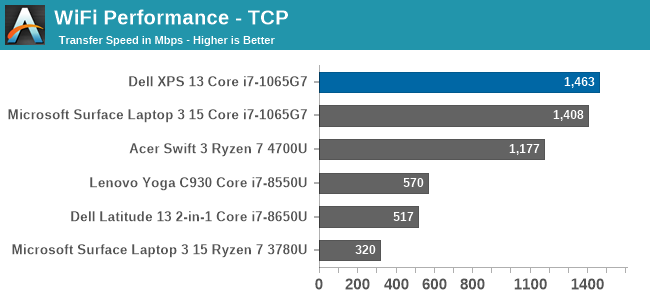
Performance is simply fantastic, and ever since Killer was able to base their network cards on Intel wireless, the stability concerns appear to be a forgotten memory. There was not a single time that the laptop had any issues with its network connection during any of the testing. That was certainly not the case on some of the older Qualcomm-based Killer products.
Audio
Dell offers Waves MaxxAudio Pro stereo speakers, at 2.5 Watts peak each, which are outfitted on the bottom of the laptops right on the edge of the device.
Sound quality is a bit on the tinny side, with not a lot of low end at all. The speaker setup does get quite loud though, with 83 dB(A) measured one inch over the trackpad at maximum volume. There was little to no distortion at peak volume either.
The dual-microphone array is found on the very top of the bezel, which would allow it to work with the device closed. It is a great way to hide the holes, with only the 2.25 mm 720p webcam showing in the bezel itself.
Thermals
Dell outfits the XPS 13 with dual fans and a single heatpipe to cool the 15-Watt Thermal Design Power of the Core processor under the hood. They have added hidden exhaust vents in the hinge, to allow more airflow without compromising the looks. There is also a layer of GORE thermal insulation under the keyboard, which helps keep that portion cool to the touch even under load.
To see how the XPS 13 performs under load, it was run at 100% for an extended period while monitoring the device.
This graph tells an interesting story, unlike most laptops we see. First, Dell has gone absolutely crazy with the PL2 level on the XPS 13, with a peak measurement of a whopping 42 Watts. But, that is not sustainable in a 13-inch laptop, and the CPU throttles in PL2 until it reaches the PL1 limit, which is right at 15 Watts in the XPS 13’s most performant mode. Most of the notebooks we have tested tend to allow a PL1 level above this, with maybe 20-21 Watts as a constant, but Dell clamps to 15 Watts, then spikes back up when the thermals allow, so we see this see-saw effect of the device running between 15 and 30 Watts. This is similar to how the XPS 13 2-in-1 behaved, and it would be nice to see the company address this with a more consistent power delivery under sustained load.
Over the duration of the test, the device averaged 18 Watts of draw, with an average CPU temperature of 80°C, with the four cores running at 2100 MHz. During this extended run, the noise level was very restrained, only hitting around 44 dB(A) measured about one inch over the trackpad. The GORE thermal insulation also did its job, with the keyboard deck remaining cool.
Software
Dell’s included software suite is a very polished set of applications, allowing the user to quickly get the device set up, adjusted, and of course, contact support. As with most manufacturers, they include a utility to get the latest updates, called Dell Update, and that includes some maintenance utilities as well.
Dell’s Power Manager software allows you to change the power profile, as well as adjust the battery charging. The Thermal Management tab allows you to pick a fan and CPU profile, or leave it as the default Optimzed setting which works well for most scenarios.
Dell offers a plethora of battery options to maintain and extend the life of the battery. Out of the box, it comes in an “Adaptive” setting which learns your usage patterns and tries to keep the battery at a good state of charge, but you can override that to keep the battery always at 100% charge in case you need it, or if you mostly use it on AC you can set it to keep the battery to a lower level of charge to prolong its life.
The days of laptops being saddles with an almost unending array of shareware and trial software seem to be mostly over, and even though Dell included Norton with the XPS 13, it can easily be removed if necessary.


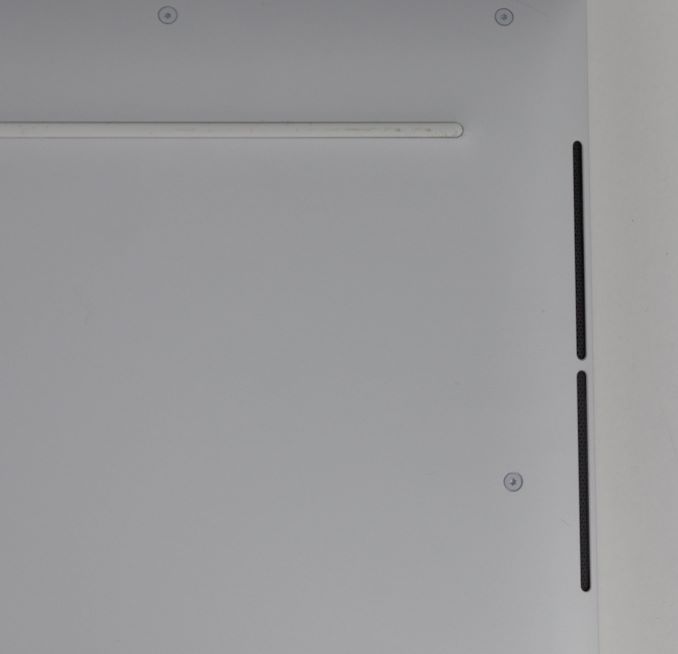
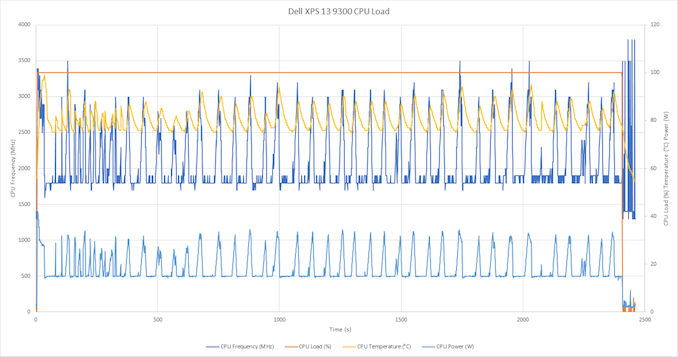
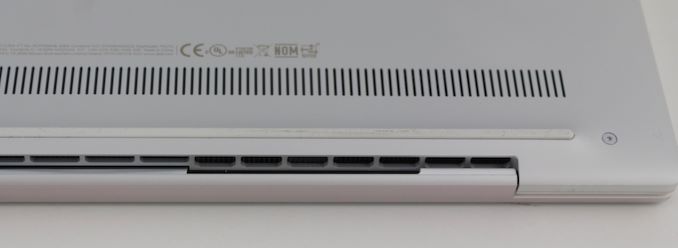

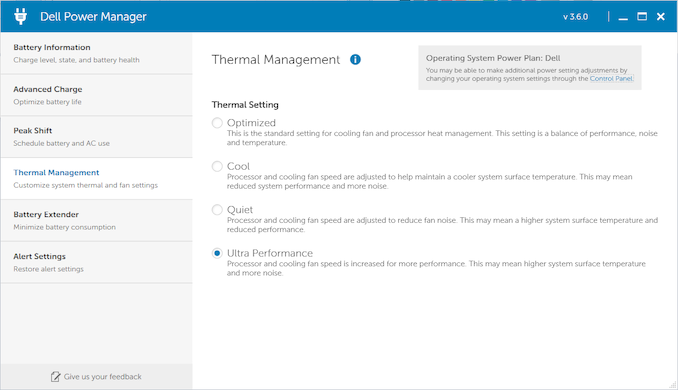
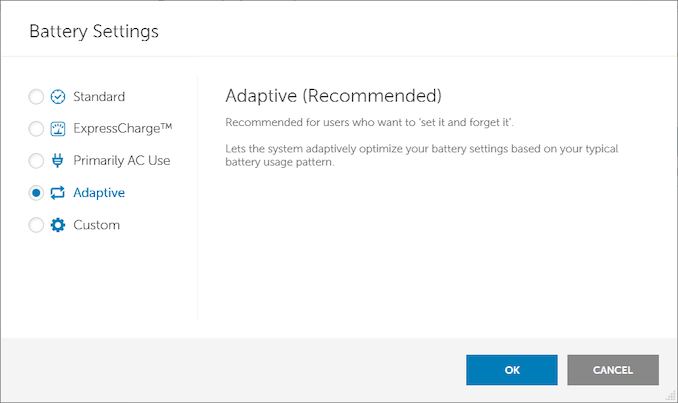








224 Comments
View All Comments
Deicidium369 - Friday, July 17, 2020 - link
I agree. OEMs will build what their customers want. I just don't see people clamoring for an AMD over an IntelKorguz - Friday, July 17, 2020 - link
of course you dont, cause you can only see intel, no matter what.vladx - Saturday, July 18, 2020 - link
No we can certainly see AMD with how they fail time and time again to launch reliable products and platforms.Korguz - Saturday, July 18, 2020 - link
seems your god intel seems to be failing quite a lot the last few years.vladx - Saturday, July 18, 2020 - link
Sorry that you're so butthurt that you try to mock others, Intel sells best because they are very reliable unlike AMD.Korguz - Saturday, July 18, 2020 - link
sorry you are butthurt cause your god intel has screwed up so bad the last few years, and that you blind to see anything else.rhysiam - Thursday, July 16, 2020 - link
Oh come on, this cherry picked "17%" claim again? See my post above. The very review you are commenting on shows highly threaded workloads pushing to AMD's advantage in the 34% to 79% range, depending on the specific workload. That is **not** "virtually matching"... and the 4700U is **not** the top Renoir.Deicidium369 - Friday, July 17, 2020 - link
"Summing up the performance metrics, the Intel Core i7-1165G7 has a lead of up to 20% in single-core performance tests while featuring a 10% clock speed advantage over the Ryzen 7 4800U (4.2 GHz vs 4.7 GHz). In multi-core tests, the Ryzen 7 4800U is 17% faster but that is despite the AMD chip having twice the number of cores and threads. But that's the fastest score for the chip with Linux OS which tends to offer higher scores. Compared to a Ryzen 7 4800U on Windows OS, the Core i7-1165G7 leads by up to 35% in single-core while being just 6% slower than its 8 core & 16 thread competitor."https://wccftech.com/intel-10nm-core-i7-1165g7-cpu...
34% higher performance in single core - slightly higher clock, but not 34% higher clocks - that's a nice IPC gain.
Not seeing the 34 to 79% AMD advantage in multicore. I am seeing the multicore being between 17% slower and 6% slower depending on the OS - with 8 cores & 16 threads vs 4 cores and 8 threads.
Just so we are working from the same materials.
Korguz - Friday, July 17, 2020 - link
yea, wccftech is a trust worthy source, arent they mostly a rumor/BS site ?Spunjji - Monday, July 20, 2020 - link
WCCFTech were running with rumours that Zen 2 would hit ~5Ghz for months before it was released, so yeah, I'd say their record isn't particularly reliable.Their comments section is also notoriously full of trolls and jackasses...